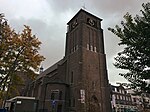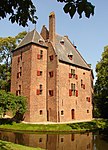Arnhem–Nijmegen metropolitan area

The Arnhem–Nijmegen metropolitan area (Dutch: Stadsregio Arnhem Nijmegen, pronounced [ˈstɑtsˌreːɣijoː ˌɑrnɛm ˈnɛimeːɣə(n); - ˌɑr(ə)nɦɛm -]; originally called Knooppunt Arnhem-Nijmegen [ˈknoːpʏnt -]) is a former Dutch plusregio, public body and intermunicipal institution, founded in 1988, for the co-operation in the areas of housing, transport and economics in the conurbation consisting of the Dutch cities of Nijmegen and Arnhem as well as the bordering municipalities of Berg en Dal, Beuningen, Doesburg, Duiven, Heumen, Lingewaard, Montferland, Mook en Middelaar, Overbetuwe, Renkum, Rheden, Rijnwaarden, Rozendaal, Westervoort, Wijchen, and Zevenaar. All except Mook en Middelaar (Limburg) are in the province of Gelderland. Its aim is regional cooperation. In 2022, a total of 774,506 people were living in the municipalities (1,000 km2). The Dutch Plusregio was abolished by law in 2014, and the Arnhem–Nijmegen metropolitan area has been liquidated 1 July 2015.
Excerpt from the Wikipedia article Arnhem–Nijmegen metropolitan area (License: CC BY-SA 3.0, Authors, Images).Arnhem–Nijmegen metropolitan area
Nieuwslag, Overbetuwe
Geographical coordinates (GPS) Address Nearby Places Show on map
Geographical coordinates (GPS)
| Latitude | Longitude |
|---|---|
| N 51.914722222222 ° | E 5.8858333333333 ° |
Address
Nieuwslag
Nieuwslag
6662 NR Overbetuwe
Gelderland, Netherlands
Open on Google Maps









